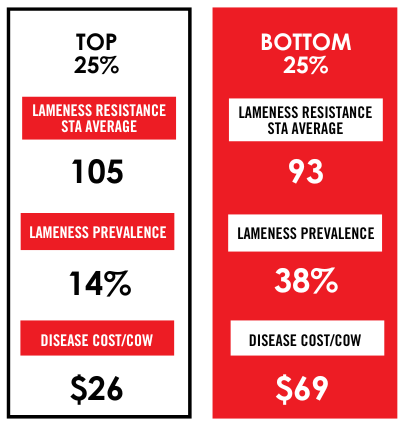With health and efficiency on the target, Larson leverages genetics to keep lameness at bay. Nationally, lameness is one of the top-five reasons that cows leave the herd and 17% of cows qualify as lame at some point during their lactation. Lameness isn’t typically an isolated incident either. As Mike explains, lameness drives down profits by depressing feed intake, milk production and fertility, not to mention associated treatment costs.
Larson Acres is a 2,900-cow herd and developing a strategy to reduce lameness begins with exceptional record keeping. In a recent interview on The Select Sires Podcast, Larson explains that every hoof trimming is initially entered into DairyComp305 as a “LAME” remark, but with the help of Brian Kelroy, dairy production specialist at Zoetis, they mine that data to pinpoint lameness events. Those events are then compared to genomic data, the best and worst quartiles are identified, and Larson Acres can make the most strategic mating decisions to generate future replacements. 
Zoetis’ Lameness Resistance trait is based on Zoetis’ multi-year field study that included 11 Holstein herds throughout the U.S. with an average 4,180 cows. The calculations for the wellness traits are updated routinely as more records are added. The Lameness Resistance trait is measured as a Standard Transmitting Ability (STA) with the average being 100. Kelroy explains, “You’re generally going to see a range from 77-80 up to maybe 113-115 for Lameness Resistance STA values. The center point is 100, consider it the average. So if we’re looking at jumping to 105, then we’re looking at a 25% decrease in incidence rate. And if you go from 100 to 95, you’re looking at a 25% general increase in incidence rate. Below 95 and we’re looking at a really high or elevated incidence rate for lameness.
Larson Acres’ incorporation of Lameness Resistance is well worth the effort and the numbers simply don’t lie. Between the top and bottom quartile, there is 63% less prevalence of lameness cases. The top 25% of cows average 105 Lameness Resistance and carry an average disease cost of $26 per cow, while the bottom quartile of cows average 93 Lameness Resistance and carry an average disease cost of $69 per cow. By genomic testing and keeping meticulous records, the Larsons can see the impact that health traits have on the dairy’s bottom line.
